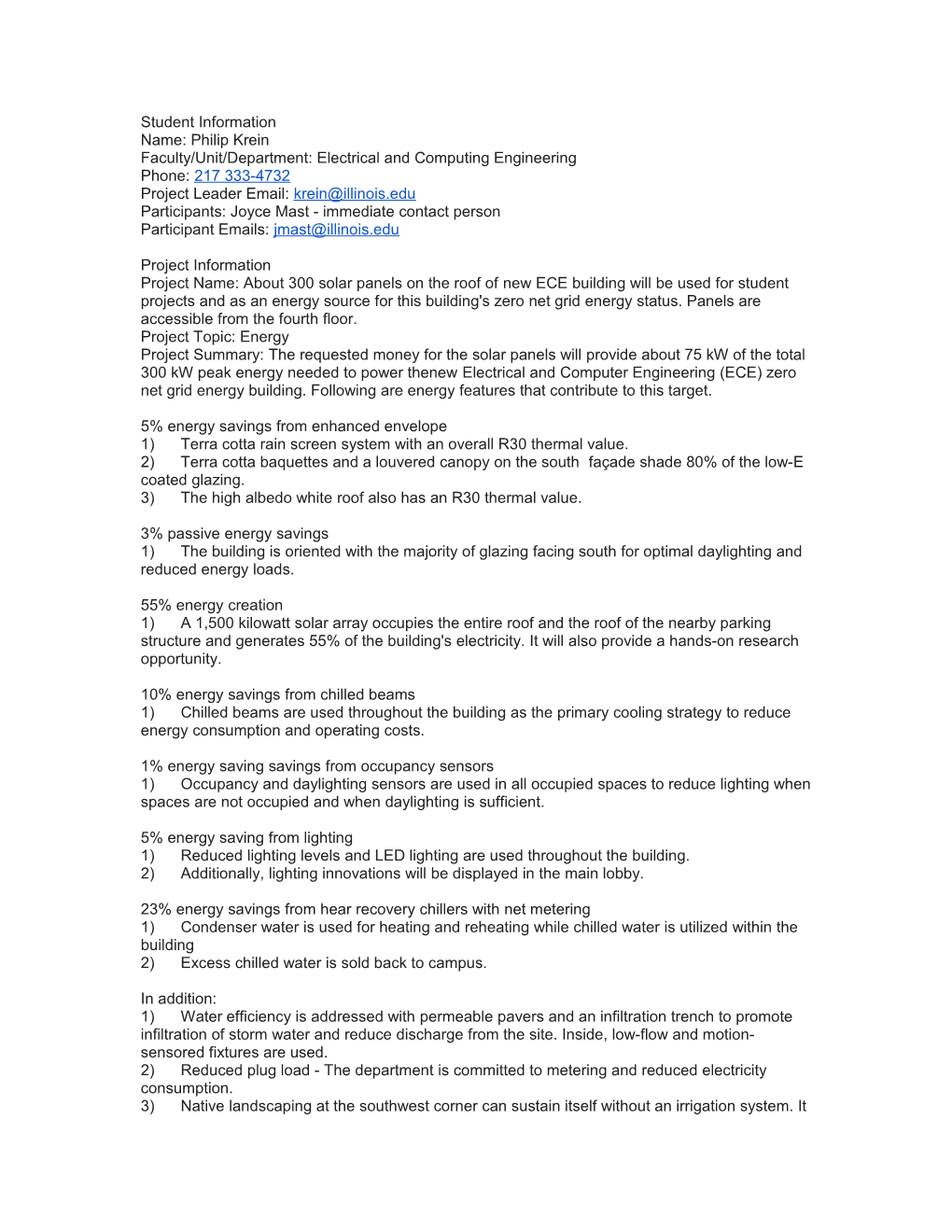Student Information
Name: Philip Krein
Faculty/Unit/Department: Electrical and Computing Engineering
Phone:217 333-4732
Project Leader Email:
Participants: Joyce Mast - immediate contact person
Participant Emails:
Project Information
Project Name: About 300 solar panels on the roof ofnewECE building will be used for student projects and as an energy source for this building's zero net grid energy status. Panels are accessible from the fourth floor.
Project Topic: Energy
Project Summary: The requested money for the solar panels will provide about 75 kW of the total 300 kW peak energy needed to power thenewElectrical and Computer Engineering (ECE) zero net grid energy building. Following are energy features that contribute to this target.
5% energy savings from enhanced envelope
1) Terra cotta rain screen system with an overall R30 thermal value.
2) Terra cotta baquettes and a louvered canopy on the south façade shade 80% of the low-E coated glazing.
3) The high albedo white roof also has an R30 thermal value.
3% passive energy savings
1) The building is oriented with the majority of glazing facing south for optimal daylighting and reduced energy loads.
55% energy creation
1) A 1,500 kilowatt solar array occupies the entire roof and the roof of the nearby parking structure and generates 55% of the building's electricity. It will also provide a hands-on research opportunity.
10% energy savings from chilled beams
1) Chilled beams are used throughout the building as the primary cooling strategy to reduce energy consumption and operating costs.
1% energy saving savings from occupancy sensors
1) Occupancy and daylighting sensors are used in all occupied spaces to reduce lighting when spaces are not occupied and when daylighting is sufficient.
5% energy saving from lighting
1) Reduced lighting levels and LED lighting are used throughout the building.
2) Additionally, lighting innovations will be displayed in the main lobby.
23% energy savings from hear recovery chillers with net metering
1) Condenser water is used for heating and reheating while chilled water is utilized within the building
2) Excess chilled water is sold back to campus.
In addition:
1) Water efficiency is addressed with permeable pavers and an infiltration trench to promote infiltration of storm water and reduce discharge from the site. Inside, low-flow and motion-sensored fixtures are used.
2) Reduced plug load - The department is committed to metering and reduced electricity consumption.
3) Native landscaping at the southwest corner can sustain itself without an irrigation system. It also will restore local habitat.
4) Recycling and regional building materials are used in addition to recycling center distributed throughout the building.
5) Displacement ventilation is used in the lobby and large auditorium to significantly improve ventilation effectiveness.
6) Science on display through the cutting-edge instructional clean room. It is enclosed by a transparent glass wall and located in the main lobby for optimum visibility.
Student Involvement: Student involvement includes
1) The following classes: ECE 333, 431, 469, and possibly a 300-400 level renewal energy class when we have the faculty to teach it. (We have hired onenewfaculty member starting in January and are waiting for the official announcement about another.)
2) Students in ECE and outside the department will use the panels for senior design, freshman labs, projects classes and components of various other classes.
3) Large student team projects, including solar decathlon teams would use the panels under appropriate supervision.
4) There will be tour access for small groups, sustainability classes, environmental classes, with the only limitation being the number of people on the roof at one time.
5) At the community level, we will have web cams, active data gathering, be able to watch sensing devices and data gathering at any time of day. Panels can be seen through windows in the building. This will help the community understand how much solar energy we receive in Urbana, as an example of solar resources in central Illinois.
6) High school classes - the panels would potentially be accessible two afternoons per week, dependent on research work of students in the ECE department.
7) Engineering Open House- an interactive display will be available.
8) The roof is accessible to people in wheel chairs.
Timeframe: We are planning on moving to thenewbuilding byJuly 14, 2014and our intention is to have the panels installed by that date.
Budget: This $225,000 request is one part of a three-to-one match of the total $900,000 cost for the solar panels for thenewECE building. It is being requested on a contingency basis. The ECE department commits to raising the remainder through private funding. If we are not able to raise it, we will return the $225,000 to the SSC.
Student Information Name: Philip Krein Faculty/Unit/Department: Electrical and Computing
